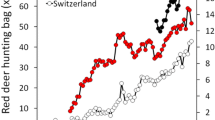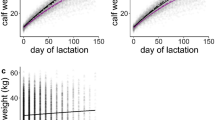Abstract
During the last 30 years, the proportion of males in the calf harvest of moose (Alces alces) in Norway has decreased, indicating a decline in proportions of males recruited to the autumn populations. At the same time, the percentages of exclusive calf hunting permits and of calves shot have increased. The change in calf sex ratio may thus simply be the result of hunter preferences for slightly larger (6.2% higher body mass) male calves combined with fewer opportunities for selective hunting due to increasing hunting quotas of calves. We examined this hypothesis by analyzing the variation in sex, number of siblings, carcass mass, date, and location of kill of 16,330 moose calves harvested during 1970–2004. In the presence of hunting selection for larger calves, we predicted larger proportions of male calves to be harvested in populations with large sexual size dimorphism among calves. Similarly, we expected more males to be harvested from twin than single litters because hunters then can more easily compare twins and select the larger calf, which is more often a male. Increasing proportions of single female calves were also expected to occur in the daily harvest as the accumulated number of harvested calves increased and the proportion of calves left in the population decreased. We found no positive relationship between the proportion of male calves and the level of sexual size dimorphism, no clear difference in sex ratio between harvested single and twin calves, and no increase in the proportion of single female calves as the accumulated number of calves in the harvest increased. This suggests that the spatiotemporal variation in the harvest calf sex ratio in Norway most likely reflects differences in population calf sex ratios prior to the hunting season and not varying degrees of hunting selectivity.





Similar content being viewed by others
References
Andersen R, Sæther B-E (1996) Elg i Norge: biologi, atferd og forvaltning. N.W. Damm and Søn A/S, Oslo, (In Norwegian)
Bates D, Sarkar D (2007) lme4: Linear mixed-effects models using S4 classes. R package version 0.99875–9
Bonenfant C, Gaillard J-M, Loison A, Klein F (2003) Sex-ratio variation and reproductive costs in relation to density in a forest-dwelling population of red deer (Cervus elaphus). Behav Ecol 14:862–869. doi:10.1093/beheco/arg077
Bubenik AB (1998) Evolution, taxonomy and morphophysiology. In: Franzmann AW, Schwartz CC (eds) Ecology and management of the North American moose. Smithsonian Institutional, London, pp 77–123
Burnham KP, Anderson DR (2002) Model selection and multimodel inference: a practical information-theoretic approach, 2nd edn. Springer, New York
Caughley G (1977) Analysis of vertebrate populations. Wiley, London
Cederlund GN, Sand HKG, Pehrson Å (1991) Body mass dynamics of moose calves in relation to winter severity. J Wildl Manage 55:675–681. doi:10.2307/3809517
Clark AB (1978) Sex-ratio and local resource competition in a prosimian primate. Science 201:163–165. doi:10.1126/science.201.4351.163
Clutton-Brock TH, Guinness FE, Albon SD (1982) Red deer: behavior and ecology of two sexes. The University of Chicago, Chicago
Cockburn A, Legge S, Double MC (2002) Sex ratios in birds and mammals: can the hypotheses be disentangled? In: Hardy ICW (ed) Sex ratios, concepts and research methods. Cambridge University Press, Cambridge, pp 266–286
Fisher RA (1930) The genetical theory of natural selection. Oxford, Clarendon, p 272
Forchhammer M (2000) Timing of foetal growt spurts can explain sex ratio variation in polygynous mammals. Ecol Lett 3:1–4. doi:10.1046/j.1461-0248.2000.00101.x
Garel M, Solberg EJ, Sæther B-E, Herfindal I, Høgda K-A (2006) The length of growing season and adult sex ratio affect sexual size dimorphism in moose. Ecology 87:745–758. doi:10.1890/05-0584
Haagenrud H, Lørdahl L (1979) Sex differential in populations of Norwegian moose Alces alces. Medd Nor Viltf 3:1–19
Herfindal I, Solberg EJ, Sæther B-E, Høgda K-A, Andersen R (2006) Environmental phenology and geographical gradients in moose body mass. Oecologia 150:213–224. doi:10.1007/s00442-006-0519-8
Markgren G (1970) Könsfördelingen hos älg-i naturen och i avskjutningen. Sven Jakt 8:389–392. In Swedish
Mathisen JH, Landa A, Andersen R, Fox JL (2003) Sex-specific differences in reindeer calf behavior and predation vulnerability. Behav Ecol 14:10–15. doi:10.1093/beheco/14.1.10
Monard AM, Duncan P, Fritz H, Feh C (1997) Variations in the birth sex ratio and neonatal mortality in a natural herd of horses. Behav Ecol Sociobiol 41:243–249. doi:10.1007/s002650050385
Myers JH (1978) Sex ratio adjustment under food stress: maximization of quality or numbers of offspring. Am Nat 112:381–388 doi:10.1086/283280
Mysterud A, Yoccoz NG, Stenseth NC, Langvatn R (2000) Relationships between sex ratio, climate and density in red deer: the importance of spatial scale. J Anim Ecol 69:959–974. doi:10.1046/j.1365-2656.2000.00454.x
Nilsen EB, Solberg EJ (2006) Patterns of hunting mortality in Norwegian moose (Alces alces) populations. Eur J Wildl Res 52:153–163. doi:10.1007/s10344-005-0023-1
R Development Core Team (2007) R: A language and environment for statistical computing. R Foundation for Statistical Computing, Vienna
Reuterwall C (1981) Temporal and spatial variability of the calf sex ratio in Scandinavian moose Alces alces. Oikos 37:39–45. doi:10.2307/3544070
Rolandsen CM, Solberg EJ, Heim M, Holmstrøm F, Solem MI, Sæther B-E (2008) Accuracy and repeatability of moose (Alces alces) age as estimated from dental cement layers. Eur J Wildl Res 54:6–14. doi:10.1007/s10344-007-0100-8
Säde S (2004) Twinning rate and foetal sex ratio of moose Alces alces in Estonia during low-density and increasing population phases in relation to maternal age. Wildl Biol 10:295–300
Sæther B-E, Haagenrud H (1985) Geographical variation in body-weight and sexual size- dimorphism of Norwegian moose (Alces alces). J Zool 206:83–96
Sæther B-E, Solberg EJ, Heim M, Stacy JE, Jakobsen KS, Olstad R (2004) Offspring sex ratio in moose Alces alces in relation to paternal age: an experiment. Wildl Biol 10:51–57
Solberg EJ, Sæther B-E, Strand O, Loison A (1999) Dynamics of a harvested moose population in a variable environment. J Anim Ecol 68:186–204. doi:10.1046/j.1365-2656.1999.00275.x
Solberg EJ, Loison A, Ringsby TH, Sæther BE, Heim M (2002) Biased adult sex ratio can affect fecundity in primiparous moose Alces alces. Wildl Biol 8:117–128
Solberg EJ, Loison A, Gaillard J-M, Heim M (2004) Lasting effects of conditions at birth on moose body mass. Ecography 27:677–687. doi:10.1111/j.0906-7590.2004.03864.x
Solberg EJ, Rolandsen CM, Heim M, Grøtan V, Garel M, Sæther B-E, et al (2006) Elgen i Norge sett med jegerøyne—en analyse av jaktmaterialet fra overvåkningsprogrammet for elg og det samlede sett elg-materialet for perioden 1966–2004. NINA Rapport 125, 197 pp (In Norwegian, with English summary)
Statistics Norway (2008) Økt utbytte under elgjakta. Available at: http://www.ssb.no/elgjakt/. Accessed 1 June 2008 (In Norwegain)
Trivers RL, Willard DE (1973) Natural selection of parental ability to vary the sex ration of offspring. Science 179:90–92. doi:10.1126/science.179.4068.90
Venables WN, Ripley BD (2002) Modern applied statistics with S, 4th edn. Springer, Berlin
Wallin K, Cederlund G, Pehrson Å (1996) Predicting body mass from chest circumference in moose Alces alces. Wildl Biol 2:53–58
Williams GC (1979) The question of adaptive sex ratio in outcrossed vertebrates. Proc R Soc Lond B Biol Sci 205:567–580. doi:10.1098/rspb.1979.0085
Acknowledgments
We are grateful to the Directorate for Nature Management and the Norwegian Research Council for financial support. We also thank all moose hunters that carefully record and report the sex and age of their moose kills each year.
Author information
Authors and Affiliations
Corresponding author
Additional information
Communicated by W. Lutz
Rights and permissions
About this article
Cite this article
Moe, T., Solberg, E.J., Herfindal, I. et al. Sex ratio variation in harvested moose (Alces alces) calves: does it reflect population calf sex ratio or selective hunting?. Eur J Wildl Res 55, 217–226 (2009). https://doi.org/10.1007/s10344-008-0223-6
Received:
Revised:
Accepted:
Published:
Issue Date:
DOI: https://doi.org/10.1007/s10344-008-0223-6




